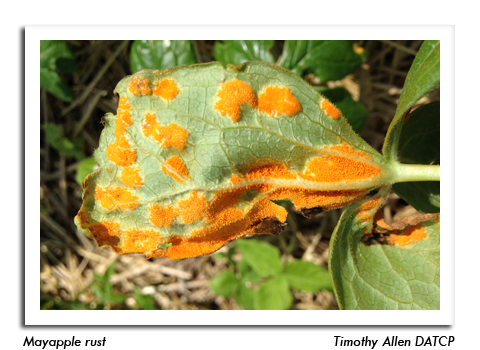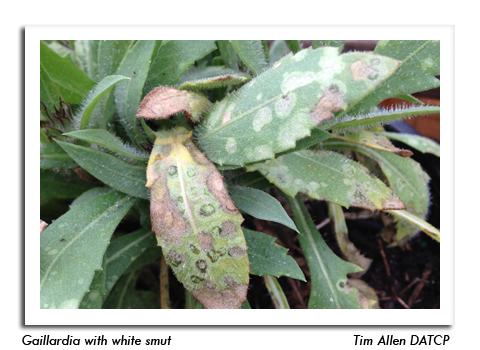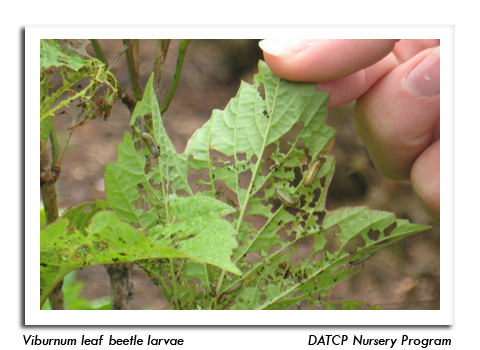
 |
|
|
Nursery & Forest
Volume 62 Number 6 Date 06/01/2017 SAWFLY LARVAE - Evidence of sawfly larval feeding was noted on cilantro, celery, carrot and parsley at plant retailers in La Crosse County. These tiny larvae skeletonize foliage or cause very characteristic windowpane feeding damage before developing into small wasps that resemble flying ants. The adult stage is a beneficial pollinator of flowering plants, but the larvae are capable of causing serious damage to vegetables and herbs. The optimal time to control sawflies is early in the larval stages, using insecticides such as Spinosad and Malathion if warranted. Bacillus thuringiensis (Bt) products are not effective against sawfly larvae. FLEA BEETLES - This common pest of many vegetables and nursery plants was observed at several retail garden centers this week, feeding on leafy seedlings and ninebark shrubs. Defoliation caused by flea beetles varies by leaf type and the flea beetle species involved, appearing as shot-holes, skeletonizing or lacy shredding on thinner leaves and a linear, leafminer-like pattern on the thicker, fleshy leaves of sedum and similar plants. Row covers, sticky traps, and insecticides may be used for prevention and treatment. Insecticides directed against the adults are the most effective control, but repeat applications are often required. MAYAPPLE RUST - Bright orange pustules were evident on the undersides of mayapples in Marathon County. This annually occurring rust is very common in natural settings where it sporadically causes premature leaf drop. Removing infected plants may aid in control by reducing the source of inoculum. ROSE MOSAIC VIRUS - The rose mosaic virus complex was again documented among several rose cultivars during recent inspections at Wisconsin retailers. Yellow leaf mottling, spots and discoloration resembling "lightning bolts" along and between leaf veins are distinctive virus symptoms. Infected plants should be removed and destroyed. Closely inspecting plants before purchase, sterilizing pruning tools between each cutting, and careful breeding of virus-free stock are foremost in preventing spread of this and other common nursery plant viruses. WHITE SMUT - This fungal disease has been reported among plants for sale in southeastern Wisconsin over the past few weeks. Found most commonly on Gaillardia or blanket flower, white smut can be recognized by the faint whitish leaf spots that enlarge and turn brown in the center, with a white border or halo. Close spacing and overhead irrigation can increase the occurrence of white smut and should be avoided. Removal and disposal of diseased foliage and infected plants is also recommended. Plants in greenhouses may benefit from fungicide applications, whereas affected landscape plantings require complete removal at the end of the season to prevent future infection. NON-VIABLE NURSERY STOCK - Nursery plants that have not leafed out by now are considered non-viable and cannot be offered for sale. Dry bulbs and trees and shrubs with plastic-wrapped roots are especially prone to moisture deficiency problems after being distributed to retail stores and should be sold within three weeks of arrival. Non-viable stock may be set aside and observed for late growth, but otherwise must be destroyed or returned to the supplier. VIBURNUM LEAF BEETLE - Eggs and early-instar larvae of this invasive European beetle are appearing on viburnums in Milwaukee County, one of two southeastern Wisconsin counties (along with Ozaukee County) in which viburnum leaf beetle (VLB) is known to be established. This newly-introduced exotic species is particularly damaging because both the adult and immature forms rapidly defoliate viburnums. Successive feeding by larvae and adults prevents shrubs from re-foliating and can kill otherwise healthy plants after 2-3 years of heavy infestation. Southeastern Wisconsin gardeners, landscapers, nursery stock growers and retailers should be alert to the characteristic, unique skeletonization of viburnum leaves caused by this insect and implement an aggressive treatment program to prevent this pest from spreading. -- Tim Boyle, DATCP Nursery Inspector 




|
|
|